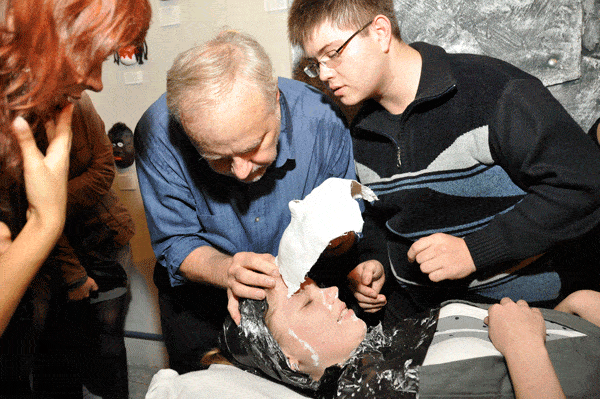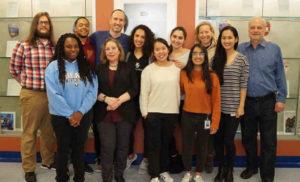It is so natural to hide your head in danger. Close your eyes in fear, be visored in battle, veil yourself in confusion, put on sun-glasses or unusual make-up. At the same time it is highly important to share your feelings with others, share your troubles aand apprehension, joy and dreams. One may do it through the mask without losing face.
“It is scary!”
“You don’t need make-up”
The girl is lying on a small table. It is so small that there is no room for her legs, they are situated on the specially put armchairs. There are black plastic bags on her head and neck and white cotton pads on her eyes.
Okay? – asks American steeping plaster in water.
Okay, – says the girl.
It was her last reply in next half an hour. Now we could know about her well-being by the special gesture – fist with turned up thumb. Under “we” I mean people who came to see a master class by New York artist and photographer Mark Scheflen who showed us how to make mask without much equipment.
“Take her hand, it is scary!” – says one compassionate woman. I have to agree with her: lying this way in full public view while being put in plaster. But all precautions are taken.
You have to anoint your face with cream beforehand to make it easier for mask to come off, – Mark comments on the job. – You need special material – plaster on cloth foundation. It swells in water but it is not dangerous for your skin because it breathes. The most important thing is to put first layers accurately because it is mask foundation and also you have to leave a hole for nose. Later when the main part of the mask is ready, we will shape the nasal septum underneath by use of thin strips.
Mark does his job adroitly and accurately. Mask-making process is hastened because all the essential components were ready in advance. Masks should be very firm because Mark travels the world with it, so he patiently put one layer over another. In 20 minutes after the end of the work mask is almost dry and could be removed. Apart from the hair caught in plaster all was well. Mark sets the hair free and literally drags the girl out of the mask: “Make faces, it will come off better!”
You can see something of that nature in childbirth scenes in films, just the words are different: “Breathe, breathe!” Finally, it happened. And all visitors breathed freely. Still, there is something sacral in it.
Mark turned over the mask and smiled because there were cotton pads with the rest of the make-up: “You see it is so convenient. You get up in the morning, put on a mask, and don’t need make-up”.
Mask edging is cut off and wrapped with the same strips and special gel glue to fix the shape and to make it firm. The next day after finishing drying up you can paint on the mask. Usual acrylic is good for it. There is no need for preliminary priming because it is handwork and asperities make it special.
Wheat flour and newspapers

Mark concerns himself with mask for 10 years. The story began 20 years ago when he decided to change the world. And he moved to Africa. In 1986 Mark decided to stay in a rural villagae in Eastern Kenya. He saw the hardships which Kenyans suffer and traditions they venerate. The first mask project was surprisingly simple: participants made paper mache from wheat flour and newspapers. And then with the masks on their faces Africans performed ritual songs praying for rain and crops.
Mark learned about magic nature of mask later. It is not customary for Africa to speak about HIV/AIDS though its prevalence is a known fact. But one-day African woman Rose consented to talk about it on the condition that Mark would help her make a mask. So the idea to tell the story through the mask without having to reveal real identity came up.
This idea formed the basis of international mask project by American organization Kiboko Projects which implements art, educational and cultural exchange programs between the countries. Youth project participants are students from South Africa, Kenya, USA and Russia. Now the works by students from First Novgorod gymnasium will travel the world. Gymnasium teachers say that in addition to mask-making students started actively study English to be able communicate via Internet with their counterparts from other countries.
It points out project’s hallmark – diversity.
For instance children made themselves beautiful and comprehensive diary-books consisting of their personal stories with photos and their background. Books covers consist of canvas painted by children.
Another project’s interest photographs. One of the images tells us that for some Kenyan children school lunch is the only meal of the day. To get it they have to stand in a long queue. There are dozens of such photographs. That is life.
There are also films made by students. “Corruption, corruption, corruption! A dreaded disease in our country. From the East to the West there is no solution which has come to an end”, – says an African student performing a play about corruption.
- Self-portrait
- But the masks impress most of all.
I’ve chosen this concept because the mask serves as a self-portrait. It recreates your face giving you your identity, so it is individual. Masks help people learn about themselves and others and more importantly to communicate among themselves and with others. It is not only an art object but serves as a self-portrait for exploration and identity, and a tool for communication, – says, Mark.
Children show in their works the issues affecting them, such as lack of understanding from adults, dreams which couldn’t come true because of the war, intention to go vegan, constant lack of food, unjustified prison term, smoking and cancer, HIV/AIDS.
Sally from New York depicted herself as the cat with the pointy wizard’s hat because her friends say that she looks like Cheshire cat when she’s smiling. And Erin’s mask shows the feeling of being trapped by the many expectations she is pushed to live up to.


